
Solution retrospective
I didn't have much difficulty working on this project, as I had some prior experience with HTML and CSS. It was a great opportunity to remember a lot of the things that my mind let go over time. The main areas of the code I'm unsure of is the CSS part. I don't know if my approach is the most efficient, as I mostly patched up some parts of it (backgrounds had gaps, so I added a background to not only the <body>, but also to the header and paragraph). My main question is regarding the "beauty" of the code in the CSS part. If anyone has any tips for ordering bits of code for ease of use that would be grealty appreciated.
Please log in to post a comment
Log in with GitHubCommunity feedback
- @MelvinAguilar
Hello there 👋. Good job on completing the challenge !
I have some suggestions about your code that might interest you.
-
You shouldn't use the
bodyelement as just another tag; it's meant to encompass the entire content of the webpage. Thebodyelement serves as the container for the main content of your HTML document. Using it for anything other than its intended purpose can lead to unexpected layout and styling issues.You should add a specific container tag inside the
bodyelement, for example,<main>, to encapsulate your entire component. Additionally, adding abackground-colorto the*selector is not recommended, as it would require you to override it for each individual element. Instead, you can declarebackground-color: #d4e1ee;directly in yourbodyselector , making it unnecessary to specify it elsewhere.
- To center the component in the page, you should use Flexbox or Grid layout. You can read more about centering in CSS here 📘.
- Avoid using 'vh' for font sizes. Screen size alone should not determine text size. For adaptable font sizes, consider using 'clamp,' but relying solely on 'vh' is not practical.
I hope you find it useful! 😄 Above all, the solution you submitted is great!
Happy coding!
Marked as helpful -
Join our Discord community
Join thousands of Frontend Mentor community members taking the challenges, sharing resources, helping each other, and chatting about all things front-end!
Join our Discord